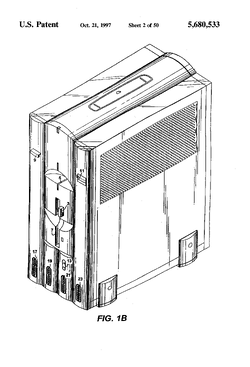Game Processor: Difference between revisions
mNo edit summary Tag: Mobile edit |
(Not needed here) |
||
| (One intermediate revision by one other user not shown) | |||
| Line 1: | Line 1: | ||
{{ | {{lost|documented=yes}} | ||
{{system infobox | {{system infobox | ||
|image=[[File:MF Figure 1B.png|250px]]<br>Unit, as seen in a patent for ''[[Mario Factory]]'' | |image=[[File:MF Figure 1B.png|250px]]<br>Unit, as seen in a patent for ''[[Mario Factory]]'' | ||
Latest revision as of 09:57, April 30, 2025
This article is about a work that used to be available to the public, but is now partially or entirely inaccessible.
However, the subject is thoroughly documented here. Only remove this notice if the complete work is recovered and made available publicly.
| Game Processor | |
|---|---|
 Unit, as seen in a patent for Mario Factory | |
| Generation | Fourth generation |
| Release date | |
The Game Processor is a software development kit created and released by Nintendo, based upon the hardware of the Super Famicom. The Game Processor was created for use in universities, namely the HAL College of Technology & Design. The inspiration to create the Game Processor came from how Nintendo's own game development seminars were always overbooked, inspiring the idea to create a development kit for use in educational spaces.[2]
According to patents, it resembles an upright Super Famicom, but with four controller ports; two for standard controllers, one for the Super Famicom Mouse, and one for a special keyboard designed for the Game Processor. It has two slots, one for cartridges on the top of the unit, and one on the front of the unit for floppy disks. The Game Processor also has a microphone jack. Games could be saved and loaded from dedicated "Game Processor RAM Cassettes", which were battery-backed Super Famicom cartridges that could be read by being inserted into the cartridge slot. Internally, the Game Processor has a 32-bit "main" CPU, running alongside a Super Famicom "game" CPU. The computers would make use of superimposition to overlay the two video outputs, giving extra information that the Super Famicom CPU could not.[3]
The primary software for the Game Processor is Mario Factory, which was distributed as a "tool disk" for use in the floppy disk drive on the front of the console.[4] Mario Factory could save to and load from the Game Processor RAM Cassette cartridges.
Gallery
References
- ^ Luigiblood. GPC Documentation Page. Retrieved April 17, 2025.
- ^ April 1993. Mycom Basic Magazine. Mycom. Page 189.
- ^ Google Patents. Security systems and methods for a videographics and authentication game/program fabricating device. Retrieved April 18, 2025.
- ^ Google Patents. Videographics program/video game fabricating system and method. Retrieved April 17, 2025.

